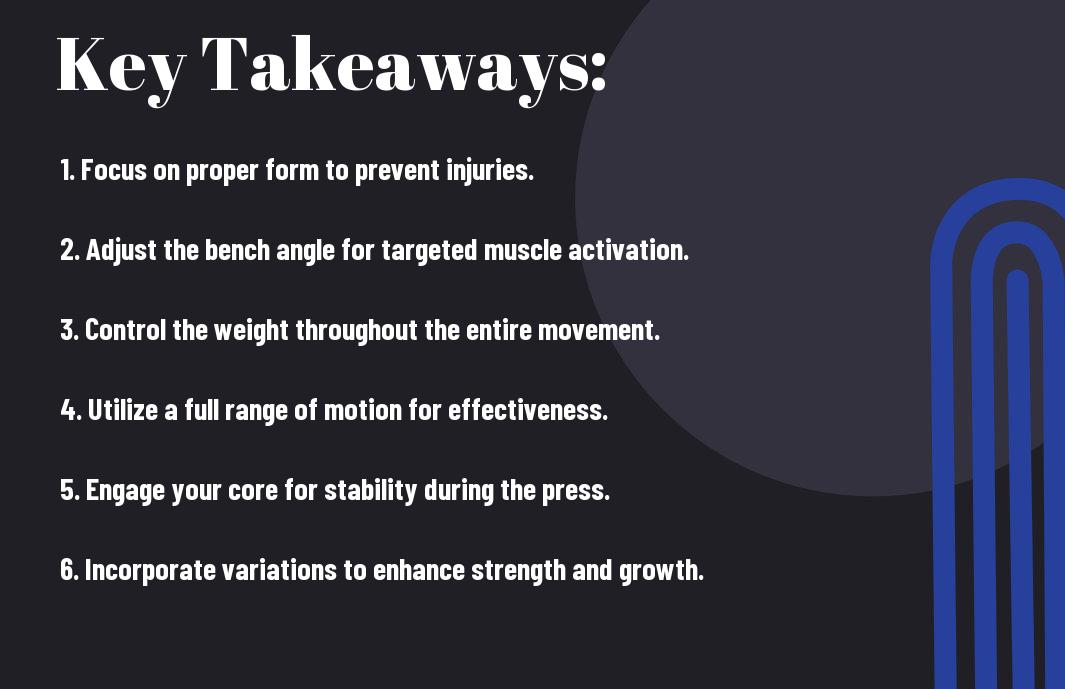Press your way to a stronger upper body by mastering the dumbbell incline bench press. This powerful exercise targets your chest, shoulders, and triceps while promoting muscle growth and stability. In this blog post, you'll discover proper techniques, important tips, and common mistakes to avoid, ensuring that you maximize the benefits of this exercise in your routine. By following these guidelines, you can enhance your strength and achieve impressive gains, all while maintaining safe lifting practices.
Understanding the Dumbbell Incline Bench Press
Your journey to mastering the dumbbell incline bench press starts with understanding its mechanics and benefits. This exercise is imperative for building upper body strength and emphasizes the upper chest muscles, offering a different training stimulus compared to flat bench presses. For detailed guidance, check out How to Do the Dumbbell Incline Press to ensure you perform it correctly.
Benefits of the Exercise
Against a backdrop of common gym routines, the dumbbell incline bench press provides a unique blend of benefits. It not only enhances muscle hypertrophy in the upper chest but also fosters shoulder stability, making it an effective choice for overall upper body development.
Muscle Groups Targeted
For those seeking to improve their muscular balance and aesthetics, the dumbbell incline bench press primarily targets the upper pectoral muscles, front deltoids, and triceps.
And as you engage in this exercise, you'll find that it also activates surrounding muscles, including the serratus anterior and the core, providing an integrated workout experience. This comprehensive engagement ensures that you build not just size but also strength across the entire upper body, enhancing your overall performance in various activities.

Proper Setup and Equipment
Even the most effective exercises can fall flat without the right setup and equipment. To maximize your performance during the dumbbell incline bench press, it’s necessary to have a reliable bench and quality dumbbells. This ensures you’re not only comfortable but also safe during your workout. Pay attention to your surroundings to prevent any unnecessary distractions and set your space for optimal lifting.
Choosing the Right Bench
Around the gym, you'll find various types of benches, but not all are suitable for the incline bench press. Look for an adjustable bench that sets at a comfortable angle for you, usually between 30 to 45 degrees. Your back should be fully supported, and the bench should be stable to allow a powerful press without wobbling.
Selecting the Appropriate Dumbbells
Above all, choosing the right dumbbells is key to your success. Opt for weights that challenge you without hindering your form. If you're new to the exercise, lighter weights allow you to master the technique before progressing to heavier ones.
Setup your dumbbell selection based on your current strength level and experience. Ideally, choose a pair that allows you to complete your sets with proper form while maintaining a degree of challenge. If you're unsure, start with lighter weights and gradually increase as your strength improves. Always prioritize form over the amount of weight to prevent injury and enhance muscle engagement.

Technique and Execution
Keep your focus on proper technique to maximize your gains and minimize the risk of injury. Start with the right equipment and ensure that the incline bench is set to a safe angle, generally between 30 to 45 degrees. As you execute the movement, pay attention to your body alignment and breathing to enhance your performance.
Starting Position
The starting position is vital for a successful dumbbell incline bench press. Sit on the inclined bench with your feet flat on the ground, ensuring your back is firmly pressed against the pad. Hold a dumbbell in each hand at shoulder level, with your palms facing forward, and brace your core for stability.
Movement Mechanics
Starting the press, you should push the dumbbells upward until your arms are fully extended, maintaining control throughout the movement. Lower the weights back down in a controlled manner until they reach shoulder height again. Be mindful to keep your elbows at a slight angle to protect your shoulders, and avoid flaring them out excessively.
This focus on movement mechanics enhances your strength development while also preventing injury. As you press the dumbbells up, engage your chest and triceps to power through the lift, feeling the muscles work. When you lower the dumbbells, maintain tension in your muscles instead of letting them go slack, which will ensure you benefit from the full range of motion. This attention to detail will contribute significantly to making the incline press more effective in your workout routine.
Common Mistakes to Avoid
All too often, lifters encounter setbacks due to common mistakes during the dumbbell incline bench press. Failing to maintain proper form or not utilizing a full range of motion can hinder your progress significantly. To enhance your technique, consider exploring Tips for incline bench and dumbbell press? : r/GYM for valuable insights from fellow gym enthusiasts.
Poor Form
Behind every successful lift is the need for proper form. Neglecting this can lead to injury and less effective workouts. Ensure that your back is firmly pressed against the bench, your feet are flat on the ground, and your elbows are at the right angle throughout the exercise.
Inadequate Range of Motion
Among the most frequent errors you might encounter is failing to perform the dumbbell incline bench press with an adequate range of motion. This limitation can stall your muscle growth and strength gains.
For instance, if your dumbbells only travel halfway down, you miss the opportunity to fully engage your chest muscles. Aim to lower the weights until your elbows are at least parallel to the bench. This elongation results in deeper muscle activation and better overall development, allowing you to maximize your gains.
Variations and Progressions
Once again, incorporating variations and progressions into your dumbbell incline bench press routine can help prevent plateaus and enhance your overall strength. Feel free to experiment with different angles of incline or add more weight and resistance within your workouts. By diversifying your approach, you keep your muscles engaged and promote continuous improvement.
Different Angles of Incline
Angles play a significant role in targeting different areas of your chest muscles. By adjusting the bench to various incline levels—such as 30, 45, or 60 degrees—you can emphasize upper and middle chest activation. Make a habit of alternating these angles in your routine, tailoring your workouts to challenge your muscles in unique ways.
Adding Weight and Resistance
The importance of progressively challenging your muscles cannot be overstated. As you build strength with the dumbbell incline bench press, consider adding weight or incorporating resistance bands to further increase difficulty. This progressive overload is imperative for muscle growth and strength gains.
With the addition of weights or resistance bands, you maximize the effectiveness of your workouts. Once you can comfortably perform your target reps with a particular dumbbell weight, incrementally increase the load. This method teaches your muscles to adapt and grow stronger, enabling you to avoid stagnation. Be mindful of your form while increasing the resistance to ensure optimal results and prevent injuries.
Incorporating into Your Workout Routine
For a balanced strength training routine, the dumbbell incline bench press should be strategically integrated into your workout schedule. Aim to include it once or twice a week, allowing for adequate recovery time. You can pair it with other upper body movements to enhance muscle engagement, making sure to warm up properly beforehand. As part of a push day routine, consider following the incline press with exercises such as shoulder presses and tricep extensions for optimal upper body development.
Recommended Sets and Repetitions
Below are the ideal sets and repetitions you should aim for when performing the dumbbell incline bench press. For beginners, starting with 3 sets of 8 to 10 repetitions is effective. As you build strength, you can progress to 4 sets of 6 to 8 repetitions with heavier weights. Adjusting your reps and sets according to your training goals will help you maximize your gains.
Combination with Other Exercises
One effective way to enhance your workout is by pairing the dumbbell incline bench press with other exercises that target complementary muscle groups. This combination not only boosts overall strength but also improves muscle endurance and stability.
A well-rounded routine could include pairing the incline bench press with exercises like bent-over rows, push-ups, or lateral raises. This approach allows for a more comprehensive engagement of the upper body muscles, which can lead to better performance and muscle definition. Ensure that you balance both pressing and pulling movements to maintain muscular symmetry and prevent injury.
Summing up
With this in mind, mastering the dumbbell incline bench press is necessary for enhancing your upper body strength and building a well-defined chest. By focusing on form, gradually increasing weight, and integrating it into your workout routine, you can effectively target your upper pectorals, shoulders, and triceps. Ensuring proper technique and pre-workout warm-ups will help prevent injuries and maximize your gains. Embrace this exercise as a staple in your regimen, and you will see improvements in both strength and aesthetics over time.
FAQ
Q: What is the proper setup for the Dumbbell Incline Bench Press?
A: To set up for the Dumbbell Incline Bench Press, begin by adjusting the bench to an incline of 30 to 45 degrees. Sit on the bench with your back pressed against it, holding a dumbbell in each hand resting on your thighs. As you lie back, lift the dumbbells to shoulder height with your palms facing forward. Ensure your feet are flat on the ground for stability, and engage your core throughout the exercise.
Q: What muscles are targeted during the Dumbbell Incline Bench Press?
A: The Dumbbell Incline Bench Press primarily targets the upper portion of the pectoral muscles (chest), but it also engages the anterior deltoids (front shoulders) and triceps. By varying the incline angle, you can shift the focus between the upper chest and shoulders, making it a versatile exercise in your strength training routine.
Q: How do I ensure my form is correct while performing this exercise?
A: To maintain proper form during the Dumbbell Incline Bench Press, keep your shoulders back and down, avoiding any hunching during the lift. Lower the dumbbells in a controlled manner until they are at chest level before pressing them back up. Keep your wrist straight, not bending backward, and avoid excessive arching in your lower back. Engaging your core can help stabilize your body throughout the movement.
Q: How often should I incorporate the Dumbbell Incline Bench Press into my workout routine?
A: The frequency of incorporating the Dumbbell Incline Bench Press will depend on your overall workout plan, goals, and recovery. Typically, performing this exercise 1 to 2 times a week can be effective for building strength and muscle in your upper body. Ensure to allow for adequate recovery between sessions to promote muscle growth and prevent overtraining.
Q: What are some common mistakes to avoid when performing the Dumbbell Incline Bench Press?
A: Some common mistakes include using excessively heavy weights that compromise your form, lifting the dumbbells too quickly which can lead to injury, and allowing your elbows to flare out excessively. Also, avoid arching your back by making sure your shoulder blades remain retracted and pressed against the bench throughout the exercise. Focusing on controlled movements and proper technique will significantly enhance your workout effectiveness.













0 Comments